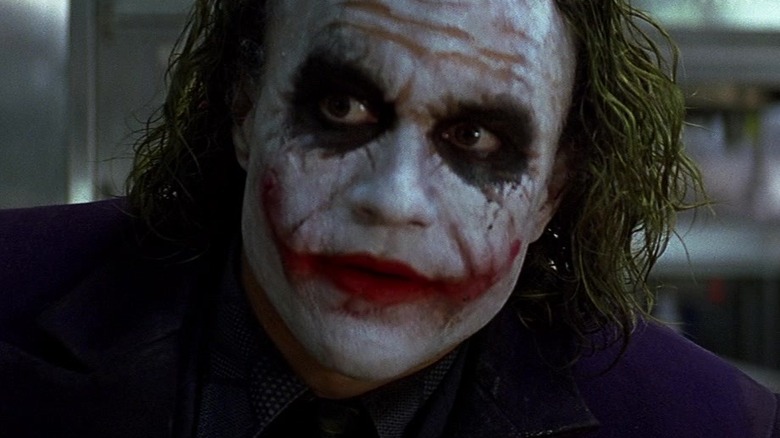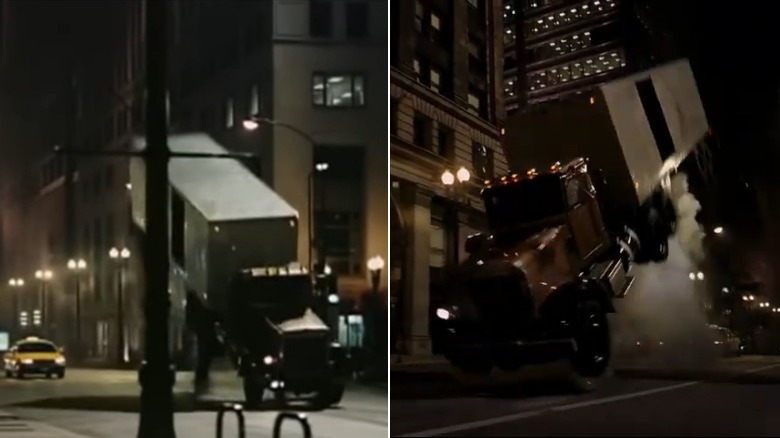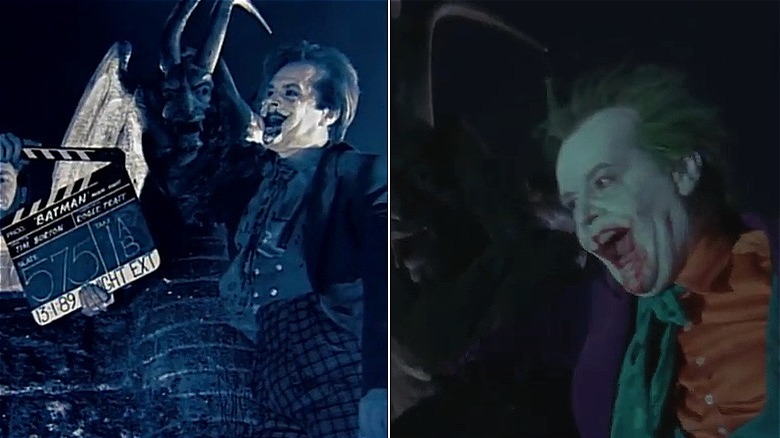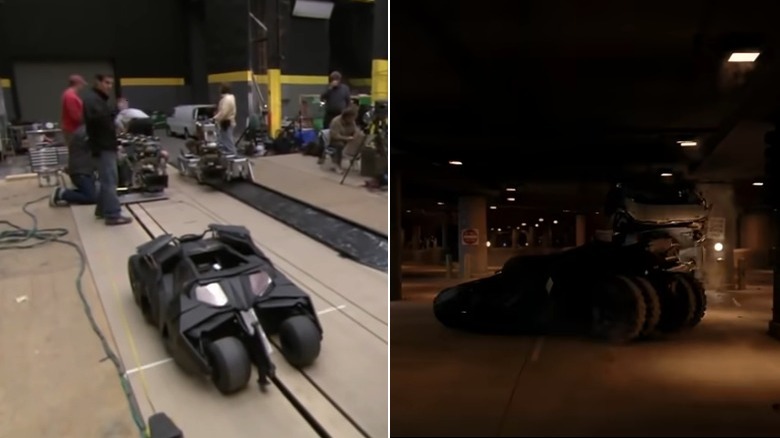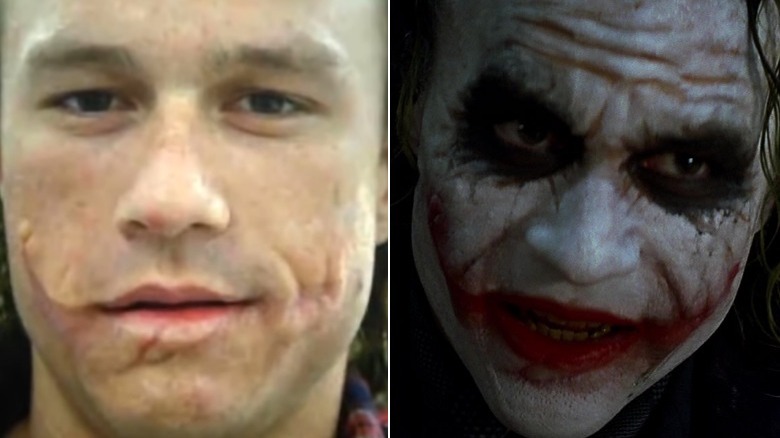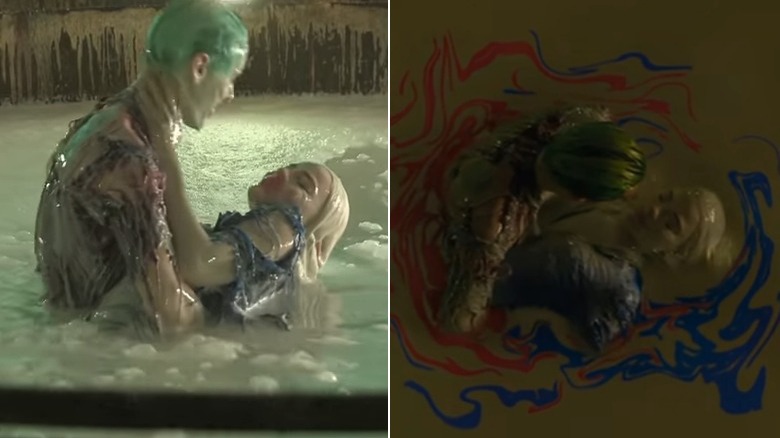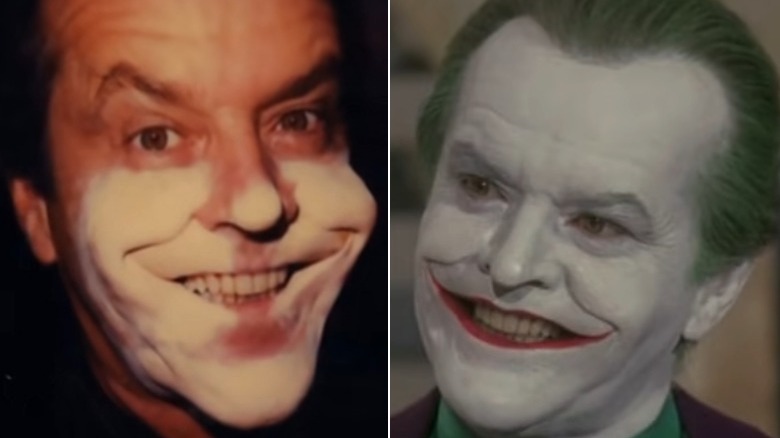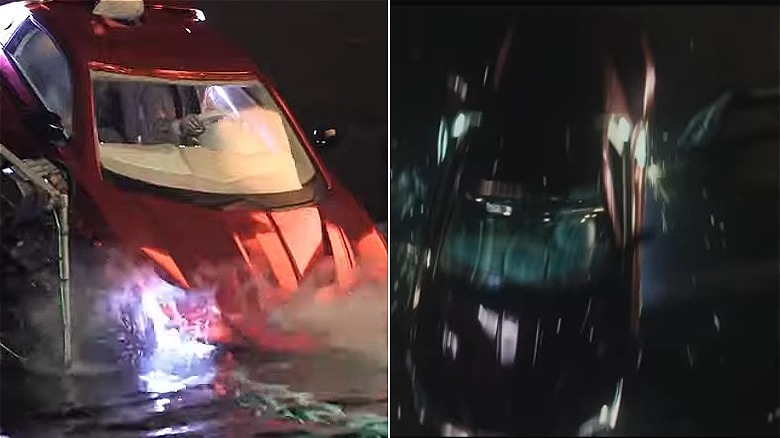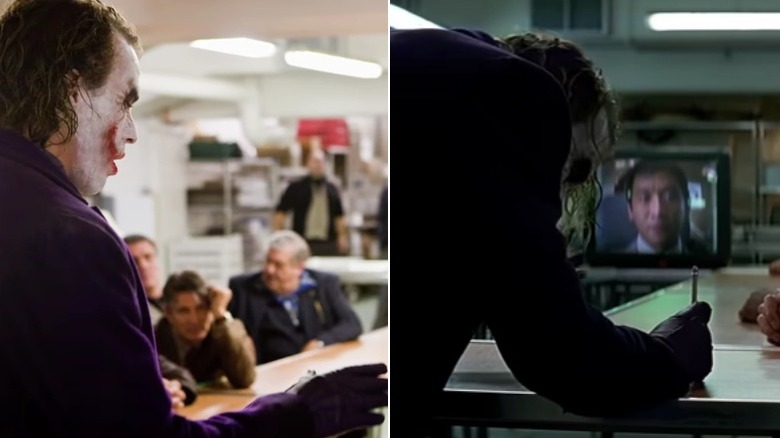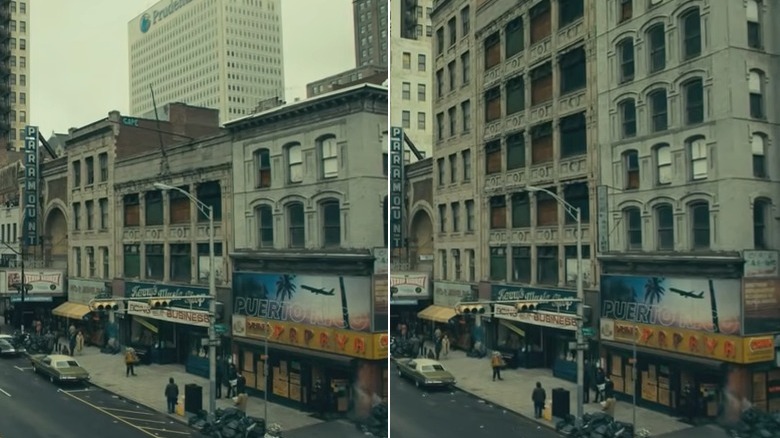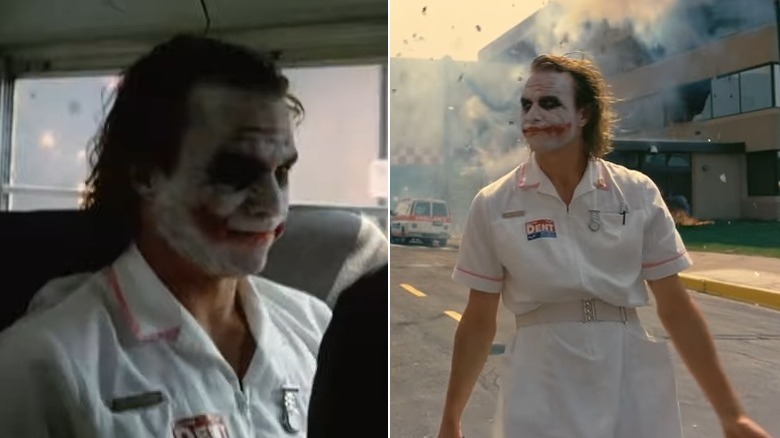What These Joker Scenes Look Like With No Special Effects
"How about a magic trick?" Thus begins one of the most iconic Joker scenes from "The Dark Knight." The line is actually quite fitting, because anytime the Joker appears on-screen is almost like a magic trick. Every Joker scene in every Batman movie is an illusion, one in which the filmmakers must convince viewers that they are indeed looking at the Clown Prince of Crime. The character goes way back (as far back as 1940, according to Rolling Stone), and each successive spin on the Joker puts even more pressure on future adaptations to do him justice. So creating a convincing Joker — as Jack Nicholson, Heath Ledger, and Joaquin Phoenix have all done — is a kind of magic in itself.
Of course, a little movie magic certainly helps. The efforts of countless visual effects artists have contributed to making each film version of Joker. Below we will examine some of their most significant contributions as well as display what the movies would have looked like without these artists' hard work. We'll cover the near-invisible special effects in the 2019 film "Joker," as well as the real reason why Heath Ledger's Joker was always licking his lips. And yes, we'll reveal where the Joker's pencil went. (Rest assured, it wasn't into the performer's eye socket.)
The Dark Knight crew flipped an actual truck
One thing that's true of every Christopher Nolan movie is that the director tries to avoid relying on CGI if at all possible. He goes out of his way to use practical effects. Although Nolan inevitably needs to use CGI in his movies, he always insists upon ending each action sequence with a shot that is 100% real. "The Dark Knight" showcases Nolan's love of practical effects, and nowhere is this more impressive than the moment in the car chase where Batman (Christian Bale) causes the Joker's (Heath Ledger) 18-wheeler to flip over.
"We really flipped that truck," producer Charles Roven explained in a behind-the-scenes special feature. "A lot of guys would have not flipped that truck. They would have done that in a visual effect." There was no CGI involved in the stunt whatsoever, except to hide the ram underneath the trailer that flipped the truck over, according to cinematographer Wally Pfister. There was even a real driver inside the steel-reinforced cab.
According to a behind-the-scenes featurette, special effects supervisor Chris Corbould wanted to use a smaller vehicle to make the stunt more feasible, but Nolan challenged him to figure out a way to make it work with the truck. Corbould had a significant challenge ahead of him, especially when he learned that the final stunt would be happening on a narrow Chicago street littered with manhole covers. Luckily, Corbould and his team succeeded at this jaw-dropping stunt, which we see in the final film.
The bell tower was only 40 feet high
Warner Bros. went all-out building Gotham City for the 1989 movie "Batman." While constructing the set at Pinewood Studios, the filmmakers put a lot of care into even the smallest details. Empire Magazine wrote that Tim Burton and his team built working traffic lights and added plumes of steam wafting up from the storm drains.
However, there was one aspect of Gotham that the filmmakers "cheated" a little to create: its height. Though you won't notice this in the final movie, the film set only extended a few stories off the ground. Most of the tall buildings on the set were cut off at 40 feet (per Empire). This includes the bell tower from the movie's climax, where Batman (Michael Keaton) and Vicki Vale (Kim Basinger) dangle off a ledge and where the Joker (Jack Nicholson) ultimately falls to his death.
Obviously, Tim Burton couldn't dangle Jack Nicholson over a thousand-foot drop. Instead, the filmmakers dangled him from a much more respectable 40 feet, with Burton and a camera positioned nearby on a scaffold, according to The New York Times. To simulate the Joker's offscreen helicopter, the effects team blasted the actors with a wind machine powered by a Volkswagen engine. To be extra safe, all the actors wore safety harnesses.
The Batmobile was sometimes a miniature
Like almost everything in the Dark Knight Trilogy, the Batmobile wasn't CGI; it was a physical vehicle that you could actually touch. The filmmakers built a working vehicle capable of jumping 6 feet in the air and swerving around tight bends, explains Insider. They used this vehicle to shoot the car chase from "The Dark Knight" where the Joker pursues Harvey Dent (Aaron Eckhart) through a Gotham underpass.
Yet there was one key stunt that wasn't done with the actual Batmobile because the filmmakers couldn't afford to damage the vehicle, according to OSSA Movies. They could, however, beat up a smaller model of the Batmobile all they wanted. The stunt from "The Dark Knight" in which the Batmobile crushes a garbage truck against the ceiling of the tunnel was created using miniature vehicles and a miniature set. The mini-Batmobile was built on a 1:3 scale, explained Christopher Nolan in a behind-the-scenes video. Nolan and his visual effects team were very careful to give the model tunnel the same dim, underexposed lighting as the full-size set, so they could switch between the two in the final film without anybody noticing the difference.
Of course, once the filmmakers were done shooting all the Batmobile scenes in "The Dark Knight," they were quite happy blowing up the Batmobile to film the shot where Joker destroys Batman's vehicle. This effect was done using the full-size Batmobile with a stunt driver inside, says Insider.
There's a reason why the Joker always licks his lips
If you ever wondered why the makeup of Heath Ledger's Joker is cracked and splotchy, that's because it was an intentional choice. In "The Dark Knight," the Joker is the sort of character who would apply his own makeup, so makeup artist John Caglione Jr. tried to make it look as though the Joker had done exactly that, according to a behind-the-scenes special feature. Caglione told CineFix that he had to fight his instincts as a makeup artist, which told him that the Joker's makeup needed to be precise and perfect. It felt wrong to him, giving the Joker sloppy makeup, but he quickly realized that was precisely the point. "Imperfection was perfection in this design," he told The Hollywood Reporter. "[I realized] I had to let my hand go."
Another aspect of Ledger's makeup also informed his character. One of the Joker's nervous tics — the way he constantly smacks his lips and sticks out his tongue — stemmed from a makeup malfunction. The Joker's scars were created by placing prosthetic makeup on Ledger's cheeks and lips, which tended to wiggle loose whenever he spoke. "The last thing Heath wanted to do was to go back and spend another 20 minutes ... trying to get the lips glued back again," explained Ledger's dialect coach, Gerry Grennell, in the documentary "I Am Heath Ledger" (via Looper). "So [Ledger] licked his lips — a lot. And then slowly that became part of the character."
Margot Robbie hated filming the chemical vat scene
Margot Robbie clearly enjoys playing Harley Quinn, and it's difficult to imagine anybody else in the role. However, there is one scene from the critically maligned film "Suicide Squad" (not to be confused with James Gunn's beloved film, "The Suicide Squad") that Robbie hated filming.
Robbie needed to take a dip into some disgusting "chemicals" to film the scene where the Joker (Jared Leto) pushes Harley into a vat at Ace Chemicals, only to dive in after her. Although the special effects team clearly used a harmless substance instead of corrosive chemicals, this repulsive liquid wasn't completely harmless. Robbie explained to The Washington Post that the substance slithered its way into her ears and nose and made her choke. "I couldn't breathe, and I tried to open my eyes, and it would glaze over my eyeballs, and I could only see white," she recalled in the same interview. "It was horrible." Jared Leto, at least, had it a little easier. His character was covered in the disgusting gunk, too, but he didn't need to be partially submerged for the shot. Robbie concluded, "That chemical [scene] was the most unpleasant thing I've ever done in my entire life."
Jack Nicholson had to wear multiple layers of makeup
When makeup artist Nick Dudman was assigned the daunting task of transforming Jack Nicholson into the Joker, he was left with very explicit instructions: Make sure that the makeup could be applied in two hours or less (per 1989Batman.com). Dudman was faced with another challenge as well, which he described in a behind-the-scenes interview. Even though he would be gluing pieces of prosthetic makeup to Nicholson's face to create the Joker's twisted smile, Dudman needed to make sure he wouldn't be covering up Nicholson's performance.
As if that wasn't complicated enough, the script dictated that the Joker would apply a layer of light-brown makeup on top of his white clown makeup to disguise himself as a regular person, which proved quite challenging for the filmmakers to do for real. Dudman shared later in the same interview that he recalled reading the script and wondering, "How the hell do you do that?" Eventually, he figured out a way to make it work.
First he applied the Joker's usual white makeup. Then he added a layer of silicon oil, to ensure that the next layer of makeup wouldn't stick to the layers underneath. Finally, he applied a bit of brown grease paint on top. "It was quite a pain to put on," said Dudman. According to a fan site dedicated to the films, Nicholson would wipe off the upper layer of makeup by using a handkerchief soaked in alcohol, which (thanks to the silicon) would not affect the layer of white makeup.
Robbie competed with her stunt double for the underwater scene
In David Ayer's "Suicide Squad," there's a scene where the Joker and Harley drive through the guardrail and plunge into the water. Once again, this is a stunt that was much easier for Jared Leto than Margot Robbie. While it appears that Leto was in the car when it was lowered into the tank of water, his character wasn't present in the shots completely underwater. (Naturally, the Joker split, leaving Harley to fend for herself.)
To film this shot, Robbie needed to train with a professional free-diver to ensure she would be able to hold her breath long enough, she told The Tonight Show Starring Jimmy Fallon. The actress was surprised at how long she could stay underwater; she was pretty impressed after she clocked in at three minutes — at least until her stunt double, Ingrid Kleinig, announced that she had held her breath for even longer. Robbie decided she wasn't going to stand for that. The two kept testing their limits, each trying to top the other, and who knows how far Robbie would have been willing to push herself had the filmmakers not stepped in and told her, "No one needs to drown over this." Since the shot in question lasted for less than 30 seconds, they kind of had a point. Holding your breath for five minutes (Robbie's personal record) is not too shabby, and Robbie joked in an interview with The Washington Post that this made for an excellent party trick.
The pencil trick used no tech wizardry
Christopher Nolan and his production designer, Nathan Crowley, worked together on "The Prestige," a film about a magician (Christian Bale) obsessed with discovering another magician's (Hugh Jackman) trick. So when the pair collaborated again on "The Dark Knight," they were no strangers to magic tricks — both in front of and behind the camera.
There was no "magic" involved in the memorable scene in which the Joker makes a pencil "disappear" by shoving it into a man's head. That is, the filmmakers didn't rely on any CGI. Certainly, they considered inserting the pencil in post-production using CGI. But visual effects supervisor Nick Davis soon discovered it would be difficult to incorporate CGI because the movie was going to be shown on a giant IMAX screen, he explained to Vulture. There wasn't a trick pencil, either, just a trick of editing. They filmed one shot where the pencil was there, and another shot (sans pencil) where the guy's head hit the table — multiple takes of each over several days. After that, they simply cut the two shots together.
Although stuntman Charles Jarman thankfully didn't have to worry about losing an eye, the stunt still hurt. As Jarman explained in the Vulture interview, the table he used was thick wood with a layer of rubber padding, which only somewhat softened the blow. "It ... felt like putting a towel over a brick wall, and running into it," he said. Jarman recalled that a few times he hit his head so hard that he blacked out.
CGI changed the skyline of Joker
"Joker" is not an action movie or even really a superhero movie, but if you guessed there were no special effects involved, you would be wrong. Actually, there are plenty of VFX shots; the effects are just so subtle they're invisible (like good visual effects ought to be). For instance, CG blood was used in the moment when the Joker (Joaquin Phoenix) smears his own blood across his face in the shape of a smile (via The Hollywood Reporter). As well, the blood shown whenever the Joker murders a character in his apartment was also computer-generated, says Polygon. This ensured that it wouldn't take as long to adjust the set and makeup between takes.
Most notably, director Todd Philips used CGI to transform New York City (where "Joker" was filmed) into Gotham City. Phillips was aiming to make Gotham resemble New York City circa 1981, but he also wanted to make sure it didn't look too much like New York — which was no easy feat, considering how recognizable the city is. According to one behind-the-scenes featurette, the special effects team added digital layers on top of existing buildings to make them seem taller and tweaked their design to match the gritty aesthetic of the movie. They added graffiti and tried to give the entire setting a worn-down, world-weary appearance. The filmmakers even edited the New York City skyline in post-production so it wouldn't be recognizable as New York.
The iconic hospital shot was done in one take
One of the best scenes in "The Dark Knight" comes when Joker blows up a hospital and then walks away like it's no big deal. Obviously, this unforgettable shot could only be filmed once, because Warner Bros. didn't have another building lying around. The filmmakers recorded the explosion on many different cameras at once from multiple angles, but ultimately they only used two shots: the shot that followed the Joker, and then the overhead shot from the helicopter. Showing any more than that would undermine the simplicity of the moment and perhaps make it seem fake. "Less was more," Christopher Nolan explained in a behind-the-scenes featurette.
The special effects team didn't blow up an actual hospital. Instead, they destroyed a building that belonged to Brach's candy company and would've been demolished anyway, according to Popcorn with Spice. Contrary to popular belief, the part where the Joker smacks his detonator, frustrated that an explosion didn't go off when it was supposed to, was not improvised. According to Metafix, the filmmakers carefully timed the explosions to include that delay.
Throughout the entire shot, Heath Ledger never looked back. No doubt it was tempting for the actor to glance back at the dangerous special effect behind him, but even when he got flecks of caulk in his hair, Ledger never broke character. "He never betrayed any sense of worrying about what was behind him," recalled Nolan during the featurette, which demonstrates Ledger's unwavering commitment to the character.
